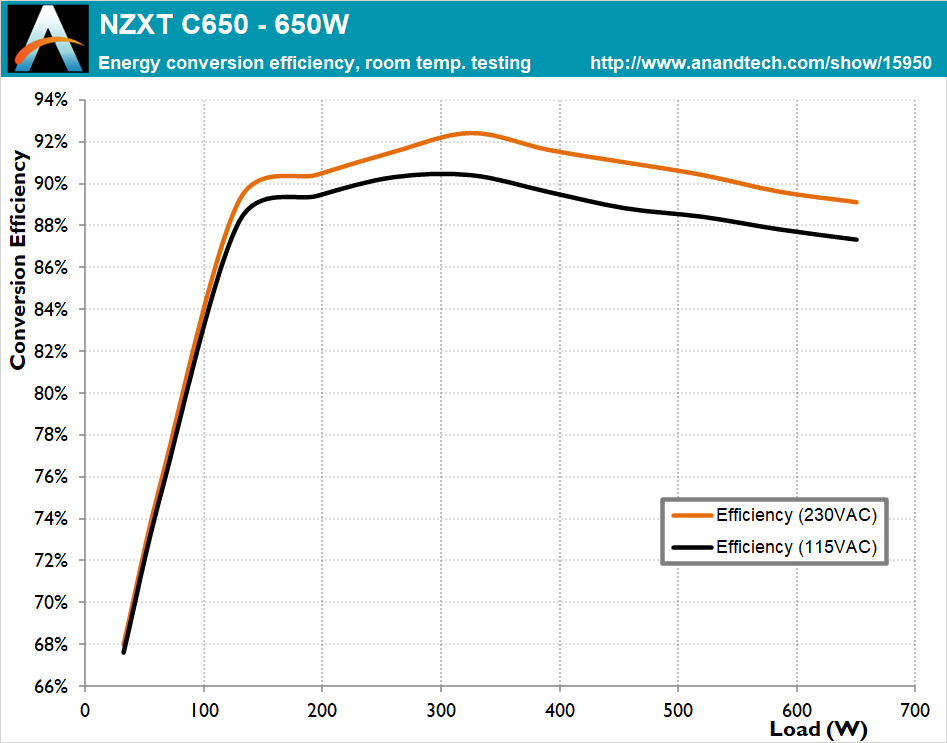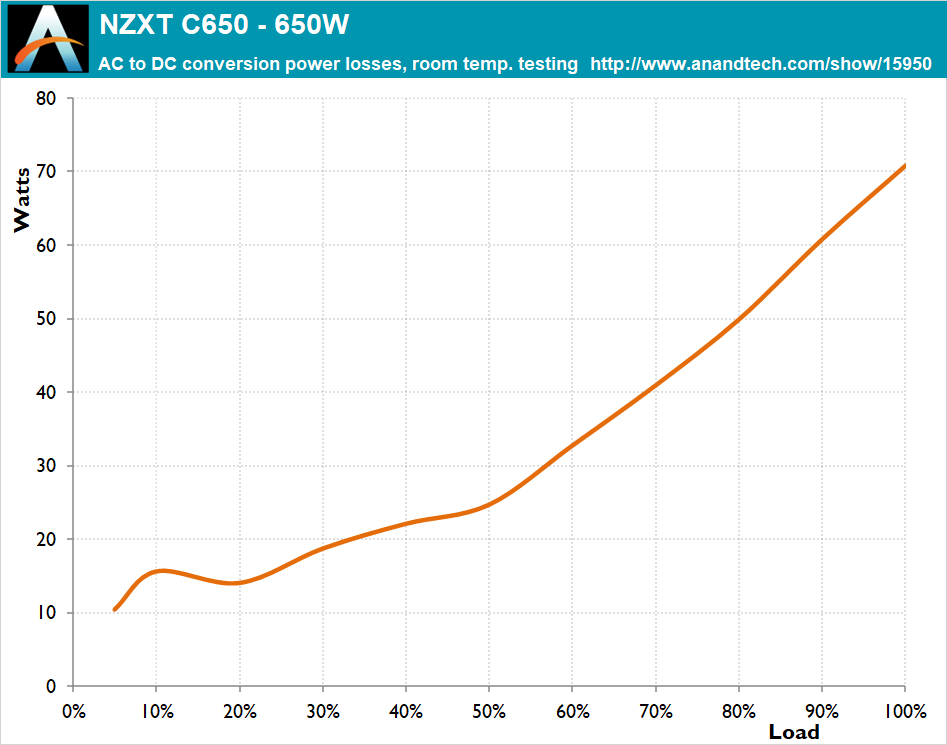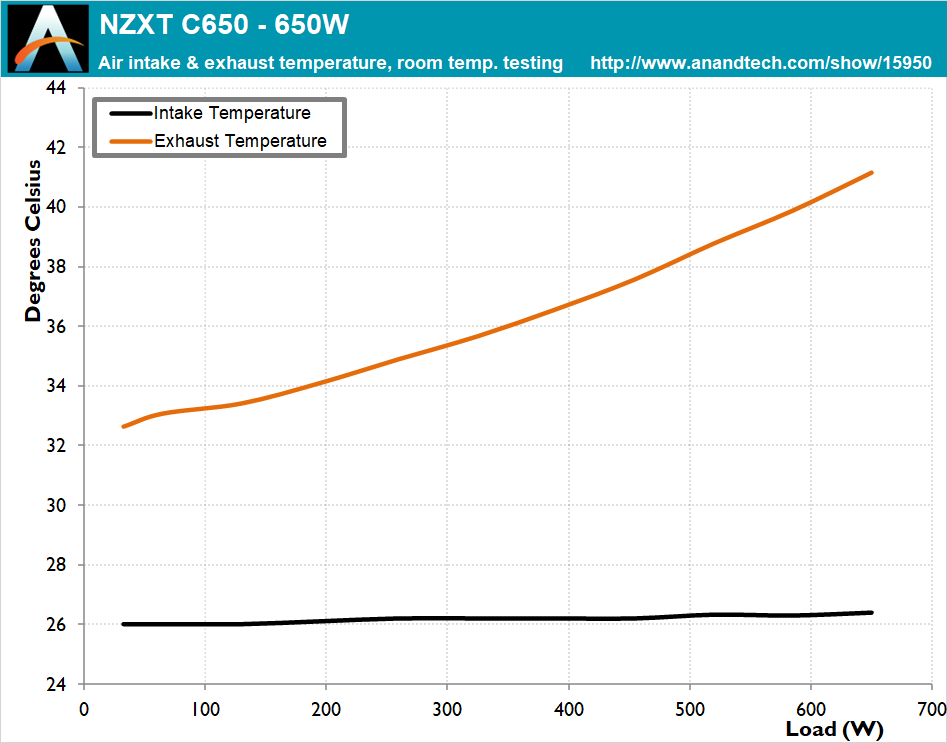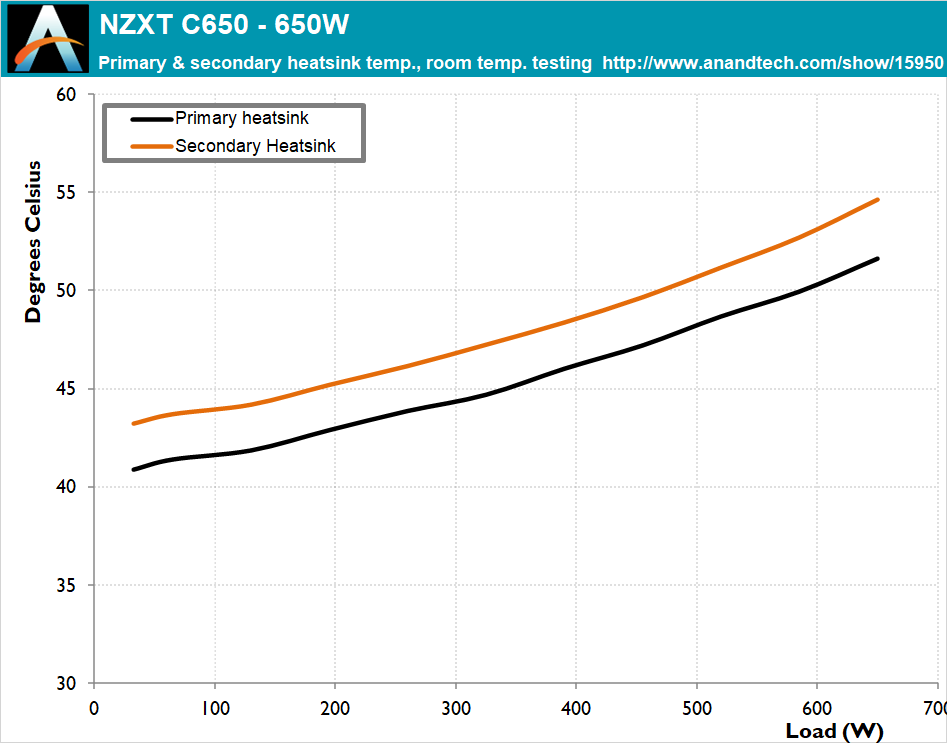The NZXT C650 650W PSU Review: Designed To Last
by E. Fylladitakis on August 11, 2020 8:00 AM EST- Posted in
- Cases/Cooling/PSUs
- PSUs
- 80Plus Gold
- NZXT
- 650W
- Modular
Cold Test Results
For the testing of PSUs, we are using high precision electronic loads with a maximum power draw of 2700 Watts, a Rigol DS5042M 40 MHz oscilloscope, an Extech 380803 power analyzer, two high precision UNI-T UT-325 digital thermometers, an Extech HD600 SPL meter, a self-designed hotbox and various other bits and parts. For a thorough explanation of our testing methodology and more details on our equipment, please refer to our How We Test PSUs - 2014 Pipeline post.
From the above charts, we can see that the NZXT C650 meets the 80Plus Gold certification requirements when powered from either a 230 VAC or 115 VAC outlet, even if only barely. It almost missed the certification requirements at 20% load and we can see that the efficiency of the PSU plummets as the load decreases, dropping well below 70% when the load is lower than 35 Watts. When the load drops below 20%, the efficiency drops so much that the raw power losses increase – a very rare effect. Apparently, this platform is not designed to cope with loads much lower than those intended.
We tested the NZXT C650 with its hybrid fan mode disabled, meaning that the fan was running at all times. In that scenario, the fan only became noticeable when the load ws greater than 320 Watts, and remained barely audible for loads up to 450 Watts. It eventually reached 42.9 dB(A) under maximum load, a passable noise figure for most users, and a great result from a PSU that is using a 120 mm fan. Considering that a PSU should never run at maximum load for prolonged periods of time, the NZXT C650 should be unnoticeable if installed inside a well-ventilated case.















34 Comments
View All Comments
Threska - Monday, August 31, 2020 - link
I could see someone going with a shorter ATX power connector. Especially since in my case it really is a short distance and most cables are really long.plonk420 - Tuesday, August 11, 2020 - link
less clutter in your case if you don't have very many components. my daily driver is a 2400G + m.2 ...and 3 SATA devicesLord of the Bored - Wednesday, August 12, 2020 - link
That doesn't explain why you'd want to remove the main ATX power connector.I grant that there ARE some situations where you don't want the motherboard power connector, but they are very rare and the people that need them are used to "manually reconfiguring" the power supply already.
GreenReaper - Wednesday, August 12, 2020 - link
You may, however, wish to replace it if the cable has been frayed somehow, or a connector broke.Might not happen for most people, but you'll be (relatively) glad if it does for you.
Arbie - Tuesday, August 11, 2020 - link
Very important info missing from your cables chart is their lengths. At least, this becomes very important if one neglects to check it...Stele - Wednesday, August 12, 2020 - link
"A trained eye will easily identify the OEM behind the NZXT C650 to be Seasonic" Ya know, it does expressly say right on the PSU label that Seasonic is the OEM...MrVibrato - Wednesday, August 12, 2020 - link
That's what makes a trained eye: To know where to look (:NeatOman - Wednesday, August 12, 2020 - link
Would have liked to see ripple measurements and at different loadsjonnyGURU - Friday, August 14, 2020 - link
Hey guys! This PSU is designed to last while all other PSUs are not!!!! What kind of bullshit marketing is that?Alien88 - Sunday, August 16, 2020 - link
Why are there almost no regular power supplies below 500W or so nowadays? A typical home PC build using an APU and SSD is never going to draw more than around 150W, yet unless you buy a flex ATX or similar PS, you are stuck using a massively overpowered PS that will have shit efficiency at typical operating powers of a regular PC. It seems that virtually all ATX PSs are aimed at the gaming market. For those who neither want nor need a separate GPU, there are very few viable choices. The sad thing is, most people buy a PC with a ridiculously overpowered graphics card simply because they might need it one day, or they simply don't know any better and think they actually need one. Vega graphics has proven that to be untrue (I have a 2400GE and yet do DTP and other graphical design and editing stuff for magazines etc without issue). Imagine how much energy is being wasted globally because of poor hardware choices and a lack of options from manufacturers.